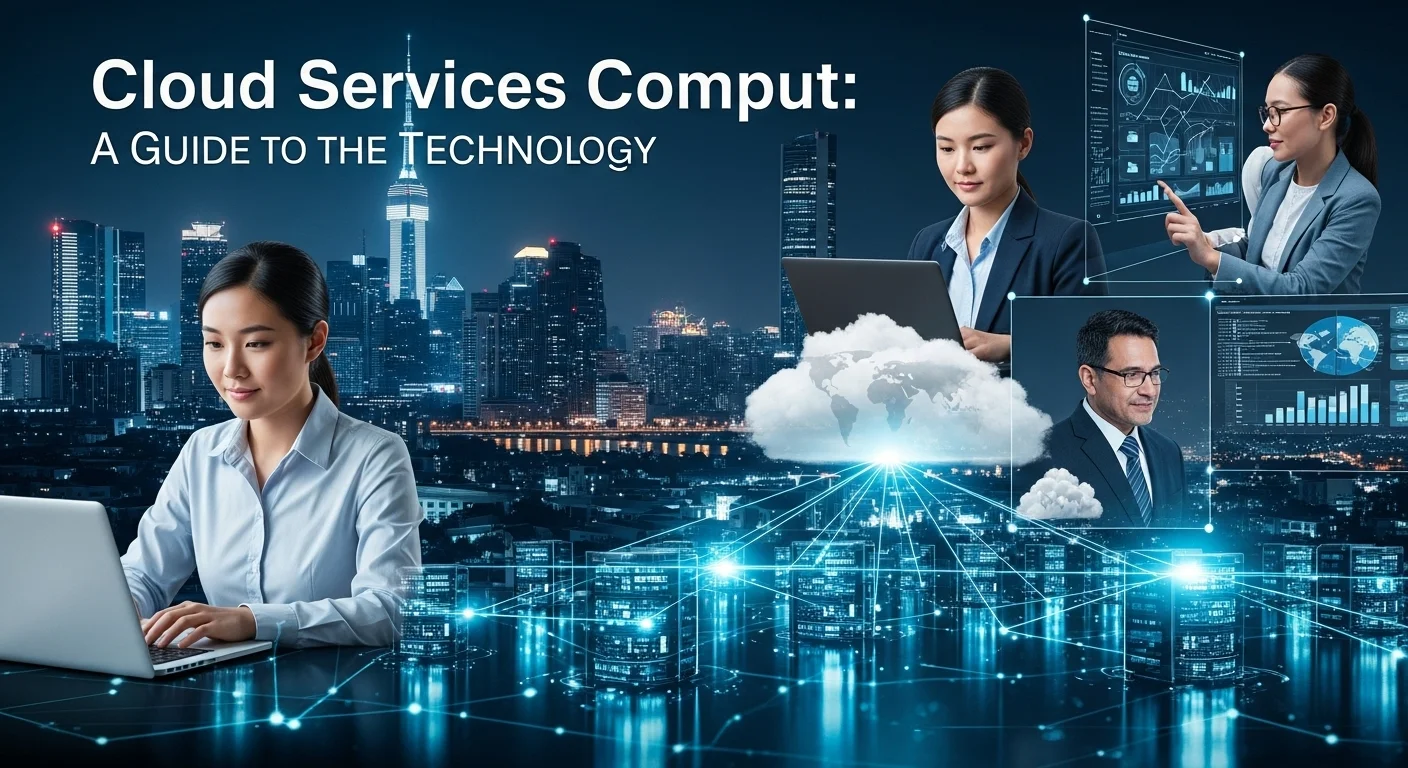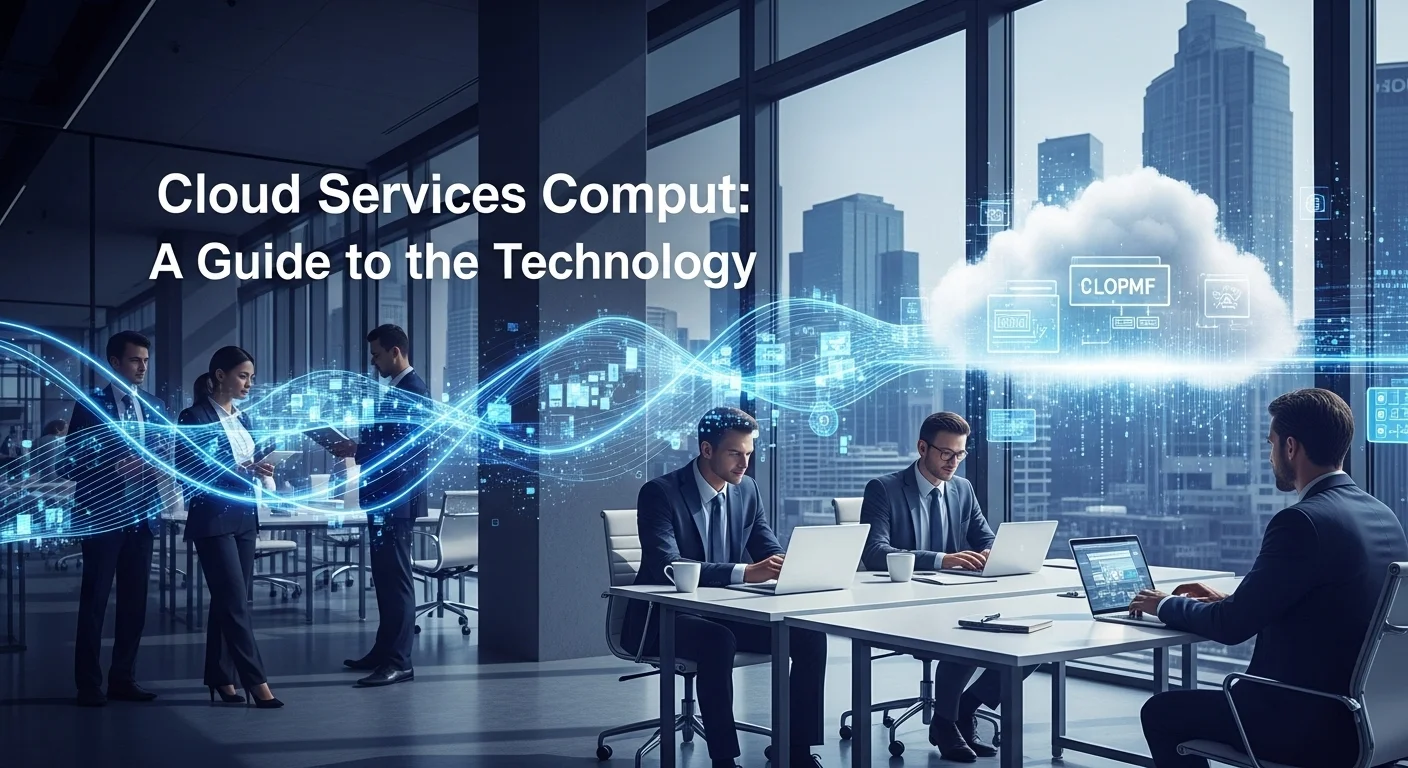Cloud Computing Explained: A Practical Guide to Cloud Services & Technology

Executive Summary
In my years as a solutions architect, I've seen 'the cloud' go from a buzzword to the absolute backbone of modern business. At its heart, cloud computing is simply about using someone else's computer resources over the internet—think storage, processing power, and software—without having to manage the physical hardware yourself. This article is my personal guide to navigating this world. We'll walk through the essential service models—IaaS, PaaS, and SaaS—which are the building blocks of any cloud strategy. We’ll also touch on more advanced tools like Monitoring as a Service (MaaS), which I consider essential for keeping things running smoothly. My goal is to demystify the relationship between cloud computing and cloud services, helping you understand how to use this technology to boost innovation, scale your operations, and find real value for your business.
Table of Contents
Table of Contents
- What is Cloud Computing and Why Does It Matter?
- The Three Main Cloud Service Models
- The Rise of Specialized Services: MaaS
- Finding the Most Affordable Cloud Service
- Choosing the Right Cloud Deployment Model
- A Look at the Major Cloud Providers
- The Vital Role of Monitoring in Business
- Best Practices for Cloud Management
- Advanced Strategies for Optimization
- Driving Innovation with High-Value Services
What is Cloud Computing and Why Does It Matter?
Whenever someone asks me about cloud computing, I tell them to forget the jargon for a second. Think of it as accessing computing services—like servers, databases, software, and storage—over the internet. Instead of buying and maintaining your own expensive hardware, you're effectively renting it from a provider. This simple shift has been a complete game-changer, moving IT costs from a huge upfront investment (buying servers) to a manageable operational expense (a monthly bill). It has leveled the playing field, giving small startups the same computing power that was once reserved for massive corporations. The relationship between cloud computing and cloud services is straightforward: cloud computing is the concept, and the services are the actual products you use within that framework.
Why Cloud Computing is a Big Deal in Tech
From my experience, the importance of the cloud boils down to a few key benefits that solve real-world business problems. First, scalability is huge. I worked with a startup that went from a handful of users to millions overnight after a viral event. With traditional hardware, they would have crashed. On the cloud, they just scaled up their resources with a few clicks. Second is cost-effectiveness. You pay for what you use, just like your electricity bill. This prevents you from overspending on hardware you don't need. Third, the flexibility it gives teams is incredible. Your developers can access their tools and data from anywhere, which is essential for today's remote and hybrid workforces. Finally, you get top-tier reliability and security. Cloud providers have entire teams dedicated to securing their infrastructure at a level most individual companies could never afford.
Understanding the Main Cloud Service Models
Cloud offerings are generally bucketed into three main models. Picking the right one depends on how much control you want versus how much you want the provider to manage for you. I like to explain it with a pizza analogy.
1. Infrastructure as a Service (IaaS)
IaaS is the most flexible model. The provider gives you the fundamental building blocks: virtual servers, storage, and networking. You are responsible for managing the operating system, applications, and data. It’s like being handed a professional kitchen with an oven, but you have to bring your own dough, sauce, and toppings to make the pizza. It gives you the most control. Great examples are Amazon EC2, Microsoft Azure VMs, and Google Compute Engine.
2. Platform as a Service (PaaS)
PaaS goes one step further. The provider manages the underlying infrastructure *and* the operating systems and development tools. You just focus on building and running your application. In our pizza analogy, this is like a take-and-bake service. They provide the kitchen and the pizza dough; you just add your favorite toppings and bake it. It’s perfect for developers who want to create applications quickly without worrying about infrastructure. Heroku and Google App Engine are classic examples.
3. Software as a Service (SaaS)
SaaS is the most common model you probably use every day. The provider hosts and manages everything: the application, the data, the servers—all of it. You just log in and use the software through your web browser. This is like ordering a pizza to be delivered hot and ready to your door. You don't have to do any of the work. Think Google Workspace, Salesforce, and Microsoft 365. It's the simplest way to use powerful cloud services.
The Rise of Specialized Services: Monitoring as a Service (MaaS)
Beyond these three, other 'as-a-service' models have appeared. One I can't stress enough is Monitoring as a Service (MaaS). MaaS tools give you a window into the health of your cloud environment. They track performance, security, and costs, alerting you to problems before they impact your users. In my experience, trying to run a serious cloud operation without a good monitoring service is like flying blind. It's an absolute necessity for maintaining a reliable and secure system.
The Quest for the Cheapest Cloud Computing Service
I get this question all the time: 'What's the cheapest cloud computing service?' The honest answer is, 'it depends.' The cheapest option isn't about the lowest price per hour; it's about the best value for your specific needs. Big players like AWS, Azure, and GCP have complex pricing but offer free tiers and deep discounts for long-term commitments. Smaller providers like DigitalOcean or Vultr might have simpler, more predictable pricing that's perfect for smaller projects. My advice is to use the providers' own pricing calculators to estimate your workload. The cheapest service is the one that fits your requirements perfectly without making you pay for features you'll never use.

Complete Guide to Cloud Technology and Business Solutions
Understanding the cloud isn't just about the tech—it's about making smart business decisions. This guide is for anyone who wants to go from simply using the cloud to strategically leveraging it for growth. It starts with Choosing the Right Cloud Deployment Model, picking the best provider for your culture and goals, and integrating services that give you a competitive edge. The real magic happens when you master the connection between cloud computing and its services to build something truly powerful.
Choosing the Right Cloud Deployment Model
Before you even look at providers, you need to decide where you want your cloud to live. This is a foundational choice that impacts cost, control, and security. I think of it like choosing where to live.
1. Public Cloud
The public cloud is like living in a large, modern apartment building. A third-party provider (like AWS, Azure, or GCP) owns and manages the building, and you rent an apartment. It’s cost-effective, you don't have to worry about maintenance, and you can easily get a bigger apartment (scale up) if you need more space. It’s perfect for websites, new app development, and businesses with changing demands. The resources are shared among tenants, which keeps costs low.
2. Private Cloud
A private cloud is like owning your own house. The infrastructure is dedicated exclusively to your organization. You have complete control and the highest level of privacy and security. You can build it on-site in your own data center or have a third party host it for you. This is the model of choice for government agencies, banks, and anyone with strict compliance needs. It offers maximum control but usually comes with a higher price tag and management overhead.
3. Hybrid Cloud
A hybrid cloud is the best of both worlds. It's like owning your house (private cloud) but renting a storage unit or a summer cabin (public cloud) when you need extra space or specific amenities. You can keep your sensitive data secure on your private cloud while using the public cloud for less critical tasks, big data processing, or disaster recovery. It offers fantastic flexibility but requires careful management to ensure the two environments work together seamlessly.
A Comparative Look at Major Cloud Providers
The cloud market has its titans, and while they all offer similar core services, each has its own personality and strengths. Choosing between them is often about cultural fit and specific technical needs.
1. Amazon Web Services (AWS)
AWS is the original and the biggest. I see them as the Swiss Army knife of the cloud. They have a service for literally everything you can imagine, from basic computing to quantum computing. Their documentation is massive, and the community support is unparalleled. Because they've been around the longest, they are a solid, mature choice for almost any use case, but their sheer number of options can feel overwhelming at first.
2. Microsoft Azure
Azure is the powerhouse for enterprises. If your company already runs on Microsoft products like Windows Server and Office 365, Azure feels like a natural extension. I've found their hybrid cloud solutions to be particularly strong, making it easier for established companies to connect their existing data centers to the cloud. It’s a very comfortable and powerful choice for large organizations.
3. Google Cloud Platform (GCP)
GCP is the specialist in data and modern apps. They leverage Google's own internal expertise in networking, data analytics, and machine learning. If your business is data-heavy or focused on cutting-edge technologies like AI and Kubernetes (which Google invented), GCP is a phenomenal choice. They are known for their high performance and developer-friendly tools.
Finding the 'Cheapest Cloud Computing Service': A Strategic Approach
The hunt for the cheapest cloud computing service should be about optimizing your total cost, not just finding the lowest sticker price. While smaller providers can seem cheaper for a basic server, true cost management is a continuous effort. Here’s my approach:
- Right-Size Everything: I've seen so much money wasted on oversized resources. Constantly monitor your usage and downgrade services that are underutilized.
- Use Smart Pricing: Don't just pay as you go. If you have a predictable workload, use Reserved Instances or Savings Plans to slash your bill by up to 70%. For non-critical jobs, Spot Instances can save you up to 90%.
- Leverage Free Tiers: Every major provider has a generous free tier. Use it for development, testing, and small projects. It's free money.
- Automate Shutdowns: A simple script that turns off development environments overnight and on weekends can save a surprising amount of money.
- Be Smart About Storage: Not all data needs to be instantly accessible. Move older, less-frequently used data to cheaper 'cold' storage tiers.
- Watch Data Transfer Costs: Getting data out of the cloud (egress) can be a hidden expense. Design your applications to minimize this.
The Critical Role of Monitoring as a Service (MaaS) in Business Solutions
In a cloud environment, things are always changing. You can't improve what you can't see, and that’s why Monitoring as a Service (MaaS) is so critical. A good MaaS platform gives you the visibility to ensure your services are fast, secure, and cost-effective. It helps you track performance, detect security threats, and spot spending anomalies. Tools like Datadog or New Relic, and even the native tools like AWS CloudWatch, are not just IT tools—they are business intelligence platforms. Integrating MaaS isn't an option; it's a core part of any successful cloud strategy.

Tips and Strategies to Improve Your Cloud Experience
Getting the most out of the cloud is more than a one-time setup; it's an ongoing practice of refinement and optimization. Here, I'll share some of the most impactful tips and strategies I've learned over the years. These practices are about building a secure, efficient, and innovative environment. By adopting this mindset, you can turn your cloud computing services from a simple utility into your company's greatest asset. The link between cloud computing and the services you use is where you can truly innovate, but only if you have a solid foundation.
Embracing Best Practices for Cloud Adoption and Management
A smooth cloud journey is built on a few core principles. These are the rules of the road that prevent chaos and ensure you're building something sustainable.
1. Develop a Strong Cloud Governance Framework
Governance sounds boring, but it's really about creating a playbook so everyone knows how to operate safely and efficiently. It’s essential for managing costs, security, and compliance. Key pieces include:
- Clear Policies: Define how resources should be named, tagged for cost allocation, and configured for security.
- Role-Based Access Control (RBAC): I live by the principle of least privilege. Only give people the exact permissions they need to do their job. This dramatically reduces the risk from a compromised account.
- Cost Management Rules: Use tags to track spending by project or team. Set up budgets and alerts to get notified before costs spiral out of control.
2. Master Security with the Shared Responsibility Model
Security in the cloud is a team effort between you and the provider. I always explain it like this: the provider is responsible for the security *of* the cloud (the physical data centers, the hardware). You are responsible for security *in* the cloud (your data, your applications, and who you give access to). To hold up your end of the bargain:
- Use Strong Identity Management: Enforce Multi-Factor Authentication (MFA) everywhere. It's one of the single most effective security measures you can take.
- Encrypt Your Data: Always encrypt sensitive data, both when it's sitting in storage (at rest) and when it's moving across the network (in transit).
- Lock Down Your Network: Use tools like virtual private clouds (VPCs) and security groups to create a secure, isolated section of the cloud for your resources.
3. Automate Everything with Infrastructure as Code (IaC)
Manually configuring your cloud environment is a recipe for disaster. It's slow and prone to human error. Infrastructure as Code (IaC) tools like Terraform or AWS CloudFormation let you define your entire setup in code. I've seen teams go from week-long deployments to pushing updates in minutes. It makes your deployments fast and repeatable, eliminates configuration errors, and lets you track changes just like you do with your application code. It's a non-negotiable for any modern cloud team.
Advanced Strategies for Optimization and Innovation
Once you've nailed the basics, you can start using the cloud to its full potential.
1. Embrace FinOps for Smart Cost Optimization
FinOps, or Financial Operations, is a cultural shift that brings financial accountability to your cloud spending. It’s not just about finding the cheapest cloud computing service; it's about getting the maximum business value from every dollar you spend. Key strategies include:
- Detect Spending Anomalies: Use monitoring tools to flag sudden cost spikes, which could signal a misconfiguration or a security issue.
- Rightsize and Schedule Continuously: Your workloads change over time. Constantly analyze usage to make sure your resources aren't oversized, and automatically shut down non-production environments when they're not in use.
- Use Serverless and Containers: Architectures like AWS Lambda (serverless) or Kubernetes (containers) can be incredibly cost-efficient because you pay only for the exact compute time you use, often down to the millisecond.
2. Harness the Power of Advanced Monitoring
Your monitoring as a service platform is a goldmine of data. To truly leverage it:
- Build Meaningful Dashboards: Create tailored dashboards that show the health of your services at a glance for different audiences—developers, executives, etc. Don't just collect metrics; tell a story with them.
- Create Actionable Alerts: Avoid 'alert fatigue' by setting up alerts that are specific and point to a real problem affecting your users.
- Use Monitoring for Business Intelligence: Connect your application performance data to your business goals. For example, how does a 100ms increase in page load time affect sales? This turns your monitoring tool into a strategic business asset.
Drive Innovation with High-Value Cloud Services
The real power of the cloud lies beyond just servers and storage. The major providers offer incredible high-level cloud services that can fast-track innovation.
- Artificial Intelligence/Machine Learning (AI/ML): Platforms like Amazon SageMaker or Google AI Platform give you the tools to build and deploy complex machine learning models without being a systems expert.
- Big Data and Analytics: Services like Google BigQuery or AWS Redshift allow you to analyze massive datasets to find insights that were previously impossible to uncover.
- Internet of Things (IoT): Platforms like AWS IoT Core make it easy to securely connect and manage data from millions of devices.
By using these tips and strategies, you can build a cloud environment that is secure, efficient, and a true engine for innovation. For a deeper dive, I highly recommend reading the AWS Well-Architected Framework, which is a fantastic resource for best practices in the cloud.
Expert Reviews & Testimonials
Sarah Johnson, Business Owner ⭐⭐⭐
The information about cloud computing is solid, but I would have loved to see more practical, step-by-step examples for small business owners like myself.
Mike Chen, IT Consultant ⭐⭐⭐⭐
This is a useful article on cloud services. It really helped clarify the topic for me, though a few of the more technical concepts could be simplified even further.
Emma Davis, Tech Expert ⭐⭐⭐⭐⭐
Excellent article! It's very comprehensive and covers cloud computing in great detail. It helped a lot with my specialization, and I understood everything perfectly. Great job!



